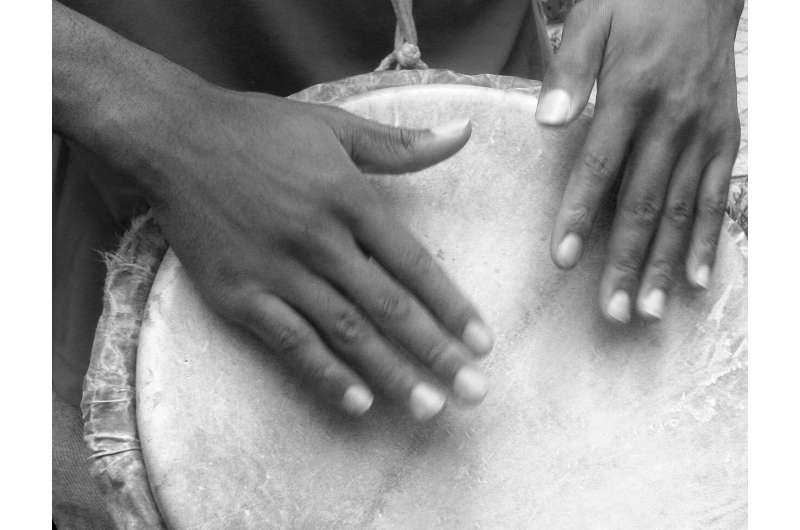The story behind the 'Moko' drums, sacred musical instruments from the Alor-Pantar archipelago

The day was still alive when a group of Abui people —the central altar of their village—alternating coordinated movements with rhythmic pauses. The drums were played, marking each step with their sounds, believed to connect the world of the gods with the world of humans.
They were performing , an integral part of ancestral rituals. The dance was directed by the cadenced rhythm produced by the , distinctive musical instruments that are also prestigious heirlooms and , mostly found in the , in East Nusa Tenggara.
Recently, with , my Research Assistant at (Suzhou, Jiangsu, China), I developed and published research about the names of the "Moko" drums and bronze gongs from Alor in three representative Papuan languages spoken in the island: (Central Alor), (Eastern Alor), and (Eastern Alor).
This research aims to increase our knowledge on the "Moko" drums and their significance and sanctity for the cultural identity and heritage of the peoples living in the Alor-Pantar archipelago.
Unclear historical references
Among the many ancestral traditions and ritual objects attested in , the "Moko" drums represent a unique blend of symbolic and religious values and practical functions in the social life of the local communities. Technically, they are bronze , specifically , instruments that produce their sounds by being hit on their vibrating skins, or membranes.
Despite their widespread use and cultural significance among indigenous communities in Alor, Pantar and beyond—like in and among the and Papuan groups of —, the history and origins of these musical instruments are still relatively obscure and seem to fade into the mists of time.
The 'bronze gongs' from the Alor-Pantar archipelago vary in size and are typically round, flat metal disks played with a mallet. They are equivalent to the "Moko" drums, .
The indigenous peoples believe that the drums and gongs have no local origins from the islands, but their possible place of production is unknown. We recently confirmed this through fieldwork conversations with our .
'Moko' drums' unique attributes
Each "Moko" drum (and bronze gong) is characterized by physical (size, shape, and the produced sounds) and aesthetic (iconography and decorations) features, which make it unique. The uniqueness of the drums and gongs is strengthened by the fact that each type of these membranophones has an 'individual' name, which indicates a specific category, with its dedicated musical and iconographic attributes.
For example, there are 'fiyaai futal' (in Abui), the "candlenut-flower" drum, and "bileeqwea / bileeq-wea" (in Abui), the "lizard-blood" drum.
All the ethnic groups in Alor, Pantar and surrounding areas use their own local variants for the names of the different drums. This nomenclature reflects specific ritual and trading features of each musical instrument.
Despite this, the native speakers cannot explain the name "Moko" in itself, with its and origins. They agree upon the likely foreign origin of the instruments, but no one can pinpoint a possible location for their production (some say Java, Makassar, India, Vietnam, or even China, but without any conclusive evidence) or the trade routes across which they were likely imported to the islands.
Some and ) tell about the unexpected discovery, by local people, of "Moko" drums buried in the ground, adding a veil of mystery to their enigmatic roots. Being treasured items, the drums were actually under the ground by locals, to avoid the risk to fall into the hands of colonizers or to be taken away by outsiders.
The term "Moko" is universally attested and used in everyday conversations by the Alor-Pantar speakers, independently of their languages and villages. However, nobody, among the locals, can explain the roots of the name or propose an interpretation for its possible meaning. The "Moko" drums are, therefore, an unsolved puzzle in the context of the material culture and linguistic landscape of the Alor-Pantar archipelago.
It is possible that the name "Moko" was coined "internally," in Alor and Pantar, perhaps in the language, which is commonly spoken in the archipelago since the . The denomination would have, then, spread towards external areas.
However, this hypothesis cannot be proven with incontrovertible evidence, and the direction of the naming process could have also been the opposite, from outside into Alor and Pantar.
presents systematic lists of the names of drums and gongs, with the original denominations in the three different above-mentioned languages, the related translations, name-by-name, synthetic notes on the possible origins of their nomenclature, a catalog of the instruments by categories (based on fieldwork and direct observation), and a set of pictures reproducing a small selection of drums according to their cultural significance.
Beyond musical functions
The "Moko" drums are relatively ancient ritual objects commonly used, in the past, in generally performed by the indigenous communities. The traditions survived until today, through local folklore and public celebrations.
The drums, as well as the related bronze gongs, still play an important role as a valuable local "currency." Highly regarded as prestigious family possessions, they are used for trade and , like .
The path towards a full understanding of the historical dynamics of the production and spread of the "Moko" drums and gongs—as well as their provenance and the etymologies of their names—might still be long. However, this does not diminish their cultural and material significance among the Alor-Pantar peoples.
Despite their obscure origins, "Moko" drums and bronze gongs are meticulously cataloged, described and rated by the local communities in the islands. Periodically, a multi-ethnic council gathers to assess, update and validate the different values and levels of social prestige and rarity of every single instrument.
This safeguarding effort, combined with the collection and systematization of , which we are currently developing, may considerably help in shedding light on the nature and origins of these enigmatic instruments.
Provided by The Conversation
This article is republished from under a Creative Commons license. Read the .![]()





















